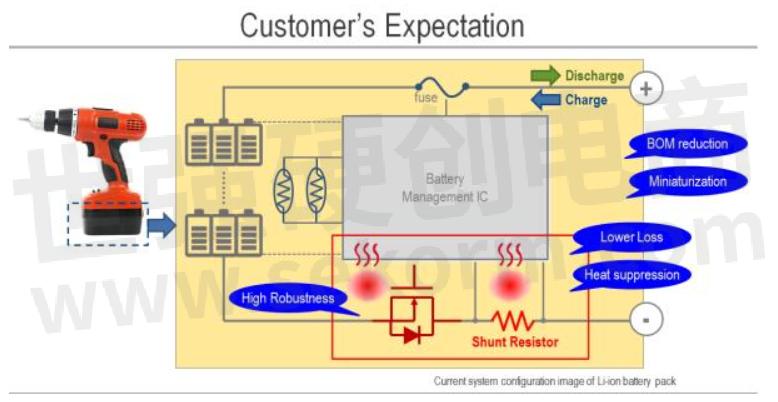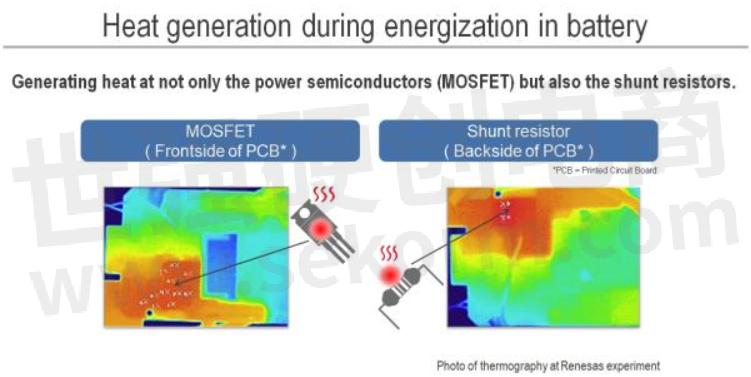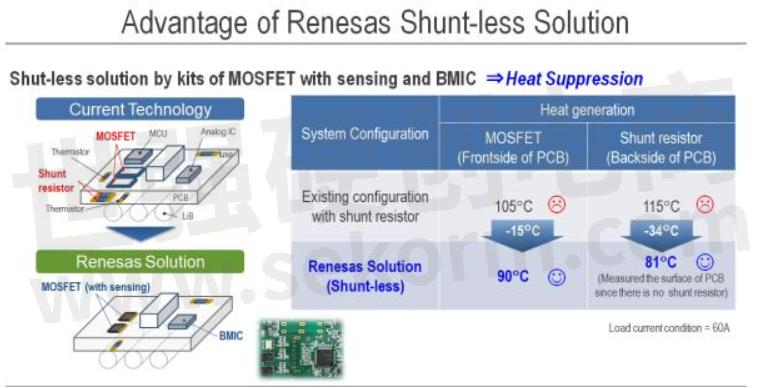Heat Suppression & Loss Reduction Solution for Li-ion Battery——Industrial Power MOSFET

This post will introduce the features of the solution for Li-ion Battery using Renesas's Industrial Power MOSFET.
Due to the influence of COVID-19 from the end of 2019, new lifestyles such as being at home have been spread. As a result, the trend of DIY (Do It Yourself) has also been increasing, and the demand of power tools and lawn mowers is increasing. Until now, it was rather an image of work tool (= professional use), but recently these products became to be seen in the sales floor of the Home Depot to target the private use.
In the past, AC type (power supply with cord) products were mainstream, but the DC type (powered by Li-ion battery) products has been increasing since there is no limit in the working range and the workability is good. In this circuit, the power semiconductor does very important work. In fact, Li-ion battery is equipped with a protection circuit to secure the safety if the abnormality was occurred, and the power semiconductors are active there. So, what do customers who plan and manufacture these products expect and have trouble with?
Customer’s Expectations: “Hard to break” & “Heat suppression
·High Robustness: Since it is a key device which shuts off the power line when an abnormality (e.g. overcurrent) occurs in the battery, power devices are required to be hard to break.
·Heat suppression: Since the loss on power line in battery generates the heat when a large current flows, the safety of Li-ion battery is threatened. It is important for Li-ion battery to reduce this loss. So, Power devices used for shut-off is also required lower loss (= lower on-resistance).
·BOM Reduction: BOM reduction is required while ensuring the same safety level as existing products.

Is there anything that Renesas power devices can support these customer’s expectations and challenges?
Renesas’ Thinking: Solving Issues including not only Power Semiconductors but also peripheral components
Towards the market request of “High Robustness” and “Lower Loss” in Automotive and Industrial field, Renesas Power MOSFET line up is prepared. The development of next generation products focuses on improving performance (= Lower on-resistance), but this performance improvement will also go to limit someday.
So, Renesas focused the resistor for current detection (=Shunt resistor) which is also inserted on the power line in the Li-ion battery. This shunt resistor generates as much heat as a power semiconductor when the current flows. In order to reduce this heat generation in the shunt resistor, the resistance value must be reduced, but there are side effects. The lower resistance value reduces the signal level from the shunt resistor, and it is necessary to review the circuits and products configuration for the signal detection (in the worst case, cost up). To reduce the resistance value of this shunt resistor also has the limitation that the resistance value cannot be “Zero”. Therefore, it is a fact that the performance improvement at system level depends on the Power semiconductor.

To breakthrough this trade-off issue, “Shunt-less solution” is under development that this solution can be realized by the Power MOSFET with current detecting function in combination with BMIC (Battery Management IC, RAJ240100GFP is used in this case). It is possible to reduce the “shunt resistor”, which is one of the factors of heat generation, and the temperature can be greatly reduced. Furthermore, it can be reduced by about 6% compared to BOM of MOSFETs and shunt resistors. This will further contribute to the safety of Li-ion battery or expand the range of applications that can be applied, such as enabling the same heat generation to support higher output.

- +1 Like
- Add to Favorites
Recommend
- Renesas DSP Solution on Renesas Lab on the Cloud, Input Analog Signals Directly From A Signal Generator To The Rx231 Microcontroller Evaluation Board
- Renesas‘ Semiconductor Manufacturing Factory (Naka Factory) Fire: Production Capacity Has Recovered to 88%
- Renesas Announces 10 New Winning Combinations Integrating Celeno and Renesas Products
- Renesas & Altran to Deploy First Social Distancing Wristwatch Using Ultra-Wideband Chipset with Low Rate Pulse
- Renesas and FAW Establish Joint Laboratory to Accelerate Development of Next-Generation Smart Vehicles
- Renesas Semiconductor Manufacturing Factory (Naka Factory)‘ Production Level Has Returned to 100%
- Renesas and Sequans Expand Their 5G Collaboration including Broadband IoT Module for 5G NR FR1/FR2
- Empower Semiconductor Showcases High-Density Power Chiplets and Embedded Integrated Voltage Regulators at APEC 2024
This document is provided by Sekorm Platform for VIP exclusive service. The copyright is owned by Sekorm. Without authorization, any medias, websites or individual are not allowed to reprint. When authorizing the reprint, the link of www.sekorm.com must be indicated.





























































































































































































































































































































































































































































































































































































































































































































































































































